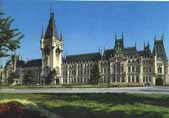The
first steps in the field of the tele-transmission of images were undertaken
towards the end of the 19th century, after the investigation of photoelectric
phenomena. The tele-transmission of static phenomena is dated back
to 1863 and is due to Italian Giovani Caselli. The device made by
him, known as pantelegraph, was improved in France (1867) and launched
on the Paris-Marseille line.
The
principle of the decomposition of image into dots was elaborated by
Carey in 1875. He designed the first device allowing the electric
emission-reception of the static image and for this purpose he used
2500 elements of Selenium whose properties had just been discovered
in 1873.
The
American Sylvanus Savier, observing the persistence of images on the
retina in their rapid succession, proposed an exploring system for
the successive transmission point by point. One step further was made
by the French Constantin Senlecq who proposed a rotative switch for
the rapid and successive transmission on a single wire of the signals
provided by the photoelectric elements.
In
1884, Paul Gottlieb Nipkov built a device for the decomposition of
the image upon its emission and respectiveley the re-composition upon
its reception with the help of a disk with milimetric perforations
arranged in spirals. The disk was spinning at a constant speed so
that the whole image was explored within a complete rotation. In 1923,
the Scottish engineer John Baird (1888-1946) obtained the license
for the use of the Nipkov disk in a so-called mechanic television
system The first successful transmission took place on 26 January
1926, in front of the members of the Royal Institute of London. It
was also Baird who, in 1928, made the first TV transmission over the
Atlantic Ocean.
Although
the cathode tube was invented by Karl Ferdinand Braun in 1897, its
use in television was inaugurated only much later, around 1939. In
the meantime, electronic tubes were improved and thus enabled the
amplification of the emitted or received signal. The first video camera
was the achievement of an American of Russian origin, named Vladimir
Kosma Zworykin (1889-1982). Zworykin imagined an electronic procedure
for image recording and this resulted in the creation of the iconoscope,
licensed in 1923. The iconoscope was tested in the RCA laboratories
and had an improved variant, the super-iconoscope, which was successfully
used in practice. It was applied in the experimental emissions carried
out by RCA and NBC from the top of the Empire State Building in New
York in 1936.
The
first regular television emissions were transmitted by BBC applying
the mechanical procedure perfected by John Baird. The first genuine
television station was built up in Berlin, Germany, in 1935, with
the occasion of the Olympic Games. In 1936, the USA chose the 441
line-television system. In England, the first television reportage
was carried out live in 1937, occasioned by the coronation festivity
of King George VI.
Colour
television was being experimented ever since 1928 by John Baird. In
1949, David Sarnoff (USA.) achieved the first colour tube at RCA and
in 1953 the NTSC system was adopted. In France, in 1956, Henri de
France presented the SECAM procedure and in 1962 the German Walter
Bruch completed the PAL system. The first broadcastings in the SECAM
and Pal systems took place in 1967.
The
Television Section traces the evolution of television, desplayinh
both graphic panels and original items, such as: the first television
receivers ever used in Romania, fully equipped reportage cabin, and
a telecinema E.M.I. installation made in England.
In
Romania, television penetrated quite late. On 14 November 1937, a
demonstrative conference arranged at the Romanian Athenaeum assured
the framework for the presentation of the first Romanian achievement
in the field of television: an image emitter made in the laboratory
of the Science Faculty of Bucharest. The first experimental television
station was made by a team directed by prof. Alexandru Spataru of
the Central Laboratory for Telecommunication Research in Bucharest.
On 23 August 1955, the experimental station started broadcasting regularly
for the few tens TV sets existing at the moment in Bucharest. At the
end of the same year, the Television Center of Bucharest was inaugurated,
being endowed with Soviet equipment. In 1964, the first colour television
demonstrations using the SECAM system took place, but it was only
in 1972 that the emission station of the Television Studio became
operational.
In
1964, the “Electronica” Enterprise produced the first
TV set designed and prepared by the local specialists: E43-110, being
followed by TV sets Dacia, Miraj and many other hybrid types, with
transistors and integrated circuits, while the first colour TV-sets
were created in 1983.

